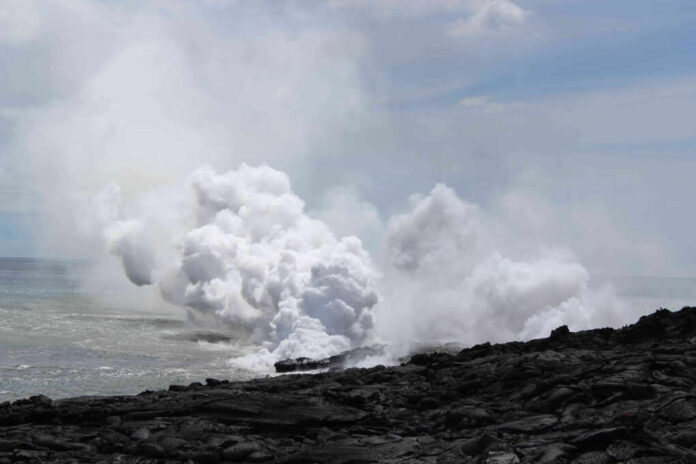
Hawaii’s Kilauea volcano continues its spectacular eruption cycle, showcasing nature’s raw power while federal agencies maintain crucial monitoring operations.
Story Highlights
- Kilauea volcano maintains active eruption status with lava fountains exceeding 1,000 feet in height
- U.S. Geological Survey forecasts potential new eruptive episode between October 17-22, 2025
- Federal monitoring systems successfully track volcanic activity to protect local communities and tourism
- Episodic eruptions since December 2024 demonstrate effective government-science collaboration
Current Volcanic Activity Shows Nature’s Force
Kilauea volcano continues demonstrating why it ranks among the world’s most active volcanoes, with spectacular lava fountains and flows contained within Halema’uma’u crater at Hawaii Volcanoes National Park. The current eruption episode began December 23, 2024, featuring dramatic lava displays reaching heights over 1,000 feet. These episodic eruptions showcase natural geological processes while remaining confined to the summit region, minimizing direct threats to surrounding communities.
Watch LIVE: Kilauea volcano erupts in Hawaii
Federal scientists maintain round-the-clock monitoring through sophisticated equipment networks that track seismic activity, gas emissions, and ground deformation. This comprehensive surveillance system enables accurate forecasting and timely public safety warnings. The volcano currently operates under a “Watch” alert level with orange aviation color codes, indicating elevated but manageable risk conditions for aircraft and local populations.
'LIVE: Kilauea volcano erupts in Hawaii'https://t.co/rNEr1lG8Yu pic.twitter.com/FdDYYVj5Ag
— Dr Can Erimtan (@TheErimtanAngle) October 17, 2025
USGS Forecasting Prevents Crisis Situations
The U.S. Geological Survey demonstrates exceptional competence in volcanic monitoring, recently forecasting a potential eruption episode between October 17 and 22, 2025. This predictive capability stems from decades of scientific investment and expertise that protects American lives and property. USGS scientists analyze multiple data streams including ground movement, earthquake patterns, and volcanic gas compositions to provide accurate early warnings to residents and emergency management officials.
Federal monitoring systems represent taxpayer dollars well-spent, delivering concrete public safety benefits through rigorous scientific methodology. These efforts prevent catastrophic scenarios like the 2018 eruption that significantly impacted nearby communities. Current monitoring protocols ensure local residents receive timely evacuation notices if conditions deteriorate, while tourists and aviation authorities get updated safety information for informed decision-making.
Economic Benefits Balance Safety Concerns
Kilauea’s ongoing volcanic activity generates substantial tourism revenue for Hawaii while federal agencies maintain necessary safety oversight. Hawaii Volcanoes National Park balances public access with protective measures, ensuring visitors experience natural wonders safely. Local businesses benefit from increased tourist interest in volcanic phenomena, though they remain dependent on federal monitoring systems for operational security and insurance considerations.
The episodic nature of current eruptions provides valuable research opportunities for American volcanologists studying geological processes. This scientific knowledge enhances long-term eruption forecasting capabilities and improves emergency preparedness protocols nationwide. Federal investment in volcanic research yields dividends through improved public safety systems and enhanced understanding of natural hazards affecting American communities from Hawaii to Alaska.
Historical Context Demonstrates Ongoing Vigilance
Kilauea’s eruption history spans decades, with significant activity dating back to 1983 and major episodes in June and September 2024 preceding the current eruption cycle. This extensive activity record provides scientists with comprehensive data sets for understanding volcanic behavior patterns and improving predictive models. The 2018 eruption serves as a critical reference point for current monitoring efforts and evacuation planning procedures.
Federal agencies coordinate effectively with Hawaii Volcanoes National Park to manage ongoing volcanic activity while preserving public access to this natural wonder. This collaboration demonstrates proper government function where scientific expertise guides public safety decisions without unnecessary bureaucratic interference. Local communities rely on these professional monitoring services for accurate information that enables informed decisions about safety and economic activities.
Sources:
Hawaii Guide – Big Island Volcanoes National Park Lava Locations
Wikipedia – Kilauea Volcano
USGS Volcano Hazards Program – Kilauea
Big Island Now – Kilauea Signs of Upcoming Eruption
National Park Service – Hawaii Volcanoes Eruptions
Hawaii Tours – Kilauea Eruptions Blog

























